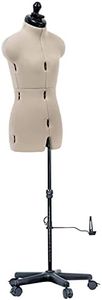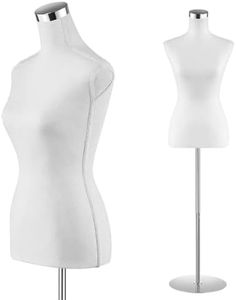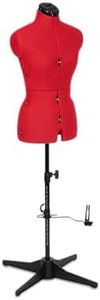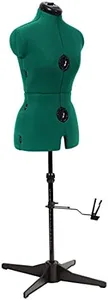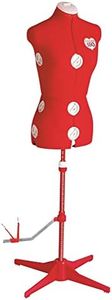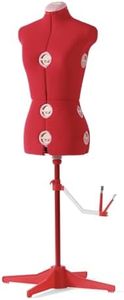We Use CookiesWe use cookies to enhance the security, performance,
functionality and for analytical and promotional activities. By continuing to browse this site you
are agreeing to our privacy policy
10 Best Dress Forms
From leading brands and best sellers available on the web.Buying Guide for the Best Dress Forms
Picking the right dress form is essential for anyone who sews, designs, or tailors clothing. A dress form acts as a substitute body for fitting, pinning, and creating garments. Your choice should match the type of clothes you make, your workflow, and the fit you’re seeking. It’s important to consider your sewing projects, how often you’ll use the form, storage space, and the adjustability you need. Getting familiar with dress form features will help you make the best choice for your unique needs.Size RangeThis spec refers to the range of body measurements (bust, waist, hips) that the dress form can represent. It’s important because a good match ensures that your garments fit as intended. Dress forms can be fixed-size or adjustable to cover several sizes. If you only sew for yourself or one person, a fixed-size close to your body shape may work. For multiple wearers or making diverse sizes, an adjustable dress form can expand and contract to fit a wider variety. Always check the sizing chart of the form and compare it carefully with the intended body measurements.
AdjustabilityAdjustability means how much you can change the dress form to match different body measurements. Some forms have knobs or dials for changing bust, waist, and hip sizes, and even height. Adjustable dress forms are helpful if you sew for people of varying sizes, or if your own body changes over time. Non-adjustable forms are sturdier and best if you consistently work with a single size. Think about whether you need to replicate multiple body shapes or just one; this will guide your need for adjustability.
Material and PaddingDress forms come in different construction styles. The outer material and the level of padding affect how well you can pin fabric onto the form or drape fabric around it. Standard forms may be made of foam and covered in fabric, making them easy to stick pins into, while basic plastic or hard forms are less pin-friendly but more durable. Tailors and serious sewists who do a lot of pinning and draping will benefit from a quality, pinnable surface. Occasional users making simple garments might be fine with harder surfaces or lighter padding.
Height AdjustmentHeight adjustment refers to whether the dress form’s stand allows you to raise or lower the torso, which lets you work comfortably whether you're seated or standing. Some stands are fixed, others allow for a wide range of heights, including lowering the form to simulate a shorter person or child. If your sewing space changes or you need to work at different levels, opt for an easily adjustable stand. This also matters if you need to check hem lengths or work on garments for people of differing heights.
Shoulder and Neck FeaturesSome dress forms offer adjustable shoulders, neck sizes, and even collapsible shoulders (which help with putting garments on and off the form). The shoulder and neck features are important if you sew fitted tops, jackets, or garments requiring precise neckline and shoulder work. If your projects include structured clothing, check for forms with realistic and adjustable shoulder/neck shaping. Those sewing flowy, loose clothing may not need these as much.
Stability and BaseThe base is what holds the form upright. A stable, heavy base keeps your dress form from tipping over as you work, while lighter or wheeled stands are easier to move. If you have a small or busy sewing area and need to move the form often, lighter or rolling options may help. If you make heavier garments or will be draping lots of fabric, a heavier, more stable base is key to keeping everything in place.



